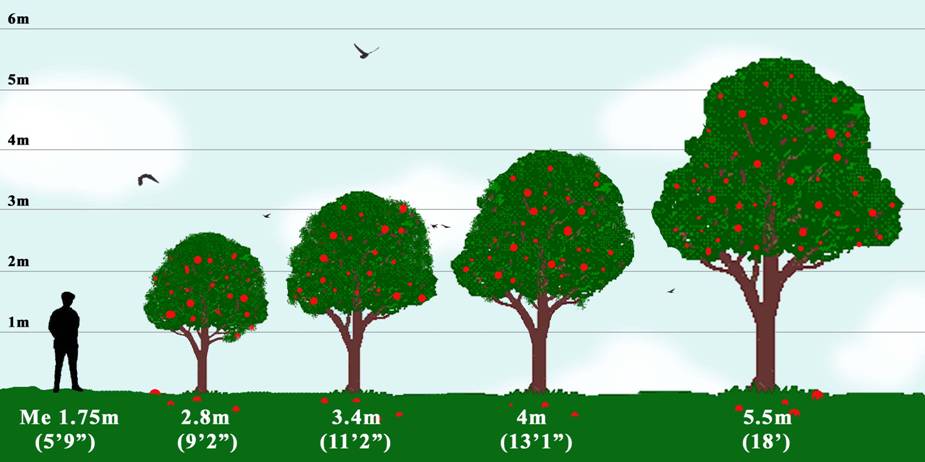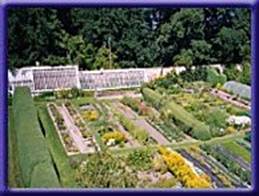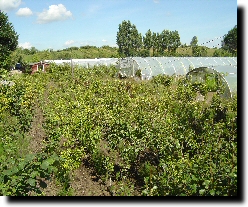 Free |
|
Grow Your Own Beer, Wine & Cider
Beer Cider & Perry Wine Rootstocks
O. K., the title may be
a bit misleading and ambitious but it is surprising what the average U. K.
brewers and winemakers can grow in their own back gardens. In the last few
years I have successfully grown my own hops and grapes, without a
greenhouse, here in
Here are two web sites that I think will be very useful, if you order from them, please mention “YoBrew”, it won’t do you any good but it may, at least, gain some “Brownie points” for us!
www.poyntzfieldherbs.co.uk www.deaconsnurseryfruits.co.uk
For the home brewer and winemakers purposes, Poyntzfield Herbs mostly supply herbs & hops, Deacons Nurseries also do hops along with fruits.
Other good sources of plants, bushes & trees include your local Woolies & Wilkinson Stores; they tend to be best during the springtime, when reasonable ranges of the more popular items are readily available.
GENERAL NOTE:- Do not plant any type of bare-rooted plants in soil that has manure added, it will be too acidic and could burn the white roots.
Beer
AGRIMONY 45cm, requires sun or partial shade, apart from flavouring beer, it can be used to produce a yellow dye, gargle for coughs & a lotion for wounds. As a home-brewer, the dye bit bothers me a little!
ALECOST or COSTMARY 90cm, is a natural insect repellent that prefers a fertile, well drained sunny or partially shaded site .Its leaves give a bitter, spicy, mint and camphor flavour. Alecost was the most popular ale flavouring used in the Middle Ages, giving it body and head as well as assisting clearing. Can be used fresh or dried in place of hops. Like mint, it is an excellent addition for new potatoes & peas.
COSTMARY see ALECOST.
DANDELION leaves, roots & flowers were apparently popular among the working classes in the 19th century, they are diuretic and need no advice as how to obtain & grow them. Flowers can be used for winemaking.
GINGER see the “Wine” entry.
HEATHER up to 45cm depending on the variety, 30 or less is more common, has been used for making Scottish Ales for over 4000 years & this is possibly the World’s oldest style still in production, the most famous is “Fraoch Heather Ale” which, I believe, also uses SWEET GALE. For 23 litres of beer, try adding 400ml of fresh heather flowers (or 200ml dried) to the hops for the last hour of the boil. A similar quantity of heather is added to the fermenter.
HOPS up to about 500cm, are now the most popular method of bittering & flavouring beers. The brewer selects his/her hop type according to the flavour & Alpha acid content. They are very easy to grow but often need some controlling; I limit mine to 2 shoots but consider 3 to be the maximum. On a summer’s day you can virtually see them grow, about 70mm in a day is not un-common. Because of their great height, it is best to let them grow up a vertical cane next to a fence post & then train them to grow horizontally. Lots of sun is required so southern/western aspects are best.
Some common varieties
available to the home-brewer:-
FUGGLE 4.5m,
the oldest traditional variety.
WYE
CHALLENGER 4.5m, is a red stemmed free flowering variety, resistant to
mildew and wilt. Sold as ‘Challenger’
GOLDINGS –
COBBS 4m, a Kent variety sold as ‘Goldings’.
GOLDINGS –
MATHON 4m, a West Country variety of similar habit to the Cobbs, also sold
as ‘Goldings’.
HALLERTAUER
4.5m, originates from Germany and is mostly used in making lagers.
FIRST
Chris Beardshaw wrote of
Hops “... although the real plant is often substituted for a synthetic
substance in mass-produced beers.” (From “A Seasoned Gardener” Daily Mail,
Saturday 4~8~’7.) This confirms suspicions that I’ve had for a very long
time!
LIQUORICE (Licorice) 1.2m, is mostly grown in the U. K. around Pontefract (hence the “cakes”), just to the left of the “Yorkshire Triangle” (see rhubarb). Because it is a legume (related to beans & peas), nitrogen, one of the very important elements of plant food, is transfixed into the soil. It is an attractive plant that rarely flowers up here in the frozen North, but this helps give extra sweetness to the roots. A well drained, loamy, soil is best & the roots can grow up to 2m. From the brewers point of view it adds a smoothness and sweetness, mainly used in stouts & porters where around 30g of the root are normally added to the boil for a 23 litre brew.
MYRICA GALE see
NETTLE 2m, a cousin of the hop that can be used to add bitterness to beers but lacks the preservative qualities of hops. For each 5 litres of beer you make, boil about 1Kg young fresh leaves & stems in 2 litres of water for 20mins. This also renders the stinging hairs harmless. Mature for at least 2 weeks before drinking.
ROSEMARY from 1 to 1.7m, added with thyme to ales before about 1400, they helped prevent the beer from spoiling and adding flavour. The ale would probably have been cloudy (not a problem until glasses were used), full of protein and carbohydrates, this is a good nutritional drink.
SWEET GALE see
TANSY 90cm, was used for bittering ales in Medieval England. It is very closely related to Alecost above, and provides an alternative taste. It hasn't got the bitterness of hops & can also be used in cooking.
THYME 5-30cm, see ROSEMARY.
YARROW 60cm, leaves and flowers have a bitter, astringent taste & a mild aroma. Can be used in place of hops, the flowers give a stronger aroma and bitterness.
Cider & Perry
By definition ciders are made from apples & perries from pears, further details of these fruits can be found from the Wine section.
CIDER APPLES are usually available on M25, M26 & M27 rootstocks, they are not self-fertile & so at least 2 trees of the same pollination group are necessary, 3 would be better and, in the case of “triploids”, they are essential. These apples typically contain about 15% sugar, 0.4% malic acid & 0.2% tannin. All apples are capable of making cider but if cider apples are not available, most recipes suggest using fairly equal quantities of eating, cooking & crab apples where possible.
ELDERFLOWERS can add bouquet to ciders but be careful as too many can be overpowering, smell the florets before using as some smell like cats pee!
PERRY PEARS are quite rare but varieties such as the Blakeney Red and the Brandy are available on the Quince rootstock, as with cider, ordinary fruit can be used.
ROSE PETALS from strong-smelling roses, picked on a sunny day when in full bloom, can be used to enhance a ciders taste & bouquet.
Wine
APPLES are usually available on M25, M26 & M27 rootstocks, varieties that are not self-fertile will need a pollinator in the neighbourhood, this is not usually a problem, but in the case of “triploids”, 2 additional pollinators in the same pollination group are essential. Bush apples are very short, 180cm or less if grown on M27 stock.. “Ballerina” apples are also available & are grown to less than 3 metres on MM106 rootstock. The growth of Ballerina trees is such that they make very short side breaks and hence no pruning is necessary. A fairly recent innovation is the self-fertile “Family Tree” which can be made up of up to 6 varieties of fruit although 2 or 3 types are more common. When pruning it is a good idea to know if the tree is “Tip” or “Spur” fruiting.
APRICOTS, PEACHES & NECTARINES like to be grown on sunny patios, against a
wall, the southern areas of the
BLACKBERRIES like sunny, moist conditions & manure; they are possibly the worst fruits to grow as they can end up everywhere! They are also delicious to eat, are excellent in wines & are now some are available in “thornless” varieties.
BLACKCURRANT bushes will tolerate some shade but they dislike cold winds. See CURRANT.
BLUEBERRYS need acidic soil, ph around 4.5; I grow mine in tubs with ericaceous compost. Unlike most berries they need another blueberry nearby for a decent crop, fruit on old wood & enjoy wet conditions. Watch out for the birds.
BULLACES see PLUMS, GAGES, DAMSONS & BULLACES.
CURRANTS like gooseberries, grow to about 1m high & enjoy damp, rich, well manured & well drained soil. They are usually grown with a 10cm or so stub before the branches appear & fruit on 1 year old wood. With Red & Whitecurrants you need to prevent the ground drying out but they will not tolerate bad drainage.
CHERRIES come in two main types, sweet, like the “Stella” and acid, like the “Morello”. Cherries are self-fertile and available as “Family Trees”. Birds are the cherry grower’s worst enemy. Do not winter prune.
DAMSONS see PLUMS, GAGES, DAMSONS & BULLACES.
ELDERBERRY/ELDERFLOWER the berries are useful ingredients for red wines, the flowers for white wines, also good for making cordials & flavoured ice cubes. Very easily grown from cuttings but smell the ‘flowers before selecting the parent, some can are quite disgusting, even so, the fruit will not be affected.
GAGES see PLUMS, GAGES, DAMSONS & BULLACES.
GINGER 60-120cm, the versatile rhizome (root) of this flowering plant can also be used in winemaking, cheese making & all sorts of cooking, especially in Asian and Mid-Eastern dishes & it can easily be propagated at home. Choose a small piece of root ginger that “looks like” it will root, it should have a shiny surface, not be wrinkled & have some little buds forming (a bit like eyes on a potato). Placing a in a smallish pot (say around 100mm) containing some general-purpose compost, have the buds facing upwards & just covered. Placing on a southern-aspect windowsill; I think it is best done during spring or early summer, a plastic bag can be placed over the pot to form a “mini greenhouse” to aid propagation. When growing, place in a decent sized pot (300mm or so diameter) & avoid direct sunlight. Water regularly but sparingly or the root will rot, do not water during Winter as the plant is dormant. Harvest when the plant dies back, suitable pieces for re-planting may have new shoots coming from them.
GORSE 2m, use about 2.25 litres of flowers for 4.5 litres of wine.
GOOSEBERRY easy to grow & an excellent winemaking ingredient, very useful for making sparkling wines. Some (old) recipes call for un-ripened gooseberries to be used, personally I would ignore that & use ripe. They do not like conditions that are too dry but bad drainage can be fatal, rich well drained soil is ideal, add plenty of Potash and spray to protect against mildew although some varieties are mildew resistant. Treat the same way as CURRANTS.
GRAPE with the effects
of global warming and the progress of science, more & more varieties are
being introduced, many of which can produce fruit in the open, in the
northern areas of the
Summer Grape vine prunings can also be used in winemaking at the rate of about 500g/4.5 litres. They should be washed in sulphited water and frozen in a plastic bag immediately after cutting. After the wine has fermented for 2 days, crush the prunings in the bag & add some cold sulphited water & leave overnight, strain into the must.
HOPS see the “Beer” entry. I have seen recipes for hop wines, hence their inclusion.
JOSTABERRY like the Worcesterberry it is a mildew resistant, heavy cropping blackcurrant/gooseberry cross & quite good for winemaking.
KIWI (Chinese Gooseberry) trees should be bought with care; I have seen them advertised singly with no mention as to their sex. (Can’t get away from it these days!) 1 male will pollinate up to 8 female plants but self-fertile “Family Trees” are available such as the Deacons Jenny Kiwi. Do NOT, as some recipes suggest, include Kiwi skins when winemaking, they add lots of unwanted tannin.
LOGANBERRIES are a cross between raspberry and blackberry, very similar to the TAYBERRY.
MEDLARS see PEARS, MEDLARS & QUINCES.
NECTARINE a smooth-skinned peach with similar acidity (about half that of
the apricot), see APRICOTS, PEACHES & NECTARINES.
PEACH see APRICOTS, PEACHES & NECTARINES
PEARS, MEDLARS & QUINCES prefer warm sheltered conditions, they are not self-fertile and so will set fruit better with a pollinator, some are triploid and need 2 additional pollinators in the same pollination group but now, many are available as self-fertile “Family Trees”. Pears only contain about 1/3 the acid of medlars & quinces.
PLUMS, GAGES, DAMSONS &
BULLACES prefer
heavy, loamy soil, usually self-fertile & available as “Family Trees”,
do not winter prune.
QUINCES see PEARS, MEDLARS & QUINCES.
RASPBERRYS like light sandy soil & are available as summer & autumn fruiting varieties, they have slightly different pruning requirements.
REDCURRANT see CURRANT.
ROSE PETALS & ROSE HIPS can both be used to make wines.
RHUBARB makes excellent sparkling wines & is at its tastiest/sweetest when “forced”. The best rhubarb is comes from “The Yorkshire Triangle” (honest! – situated between Leeds, Wakefield and Bradford). The principal acid is malic, equivalent to about 1.5% tartaric acid. Because of the high acidity, I add rhubarb to my home-made wines to correct any acid deficiency, 100g adds about 0.03% acidity to 4.5 litres. Consequently I have not used any commercial acids for many years – ideal for those who wish to make chemical free wines (and for cheapskates). At this juncture I think it prudent to point out that if a recipe names a specific acid you can ignore this & use any. This can save you money as you now only need one tub of acid rather than three, quite a few winemakers settle for tartaric acid as any excess settles out in the bottle as “argols”. DO NOT USE RHUBARB LEAVES – they contain poisonous oxalic acid.
STRAWBERRIES like sun & light sandy or rich well-drained soils. They have a useful life of 3 years, the second being the most productive. New plants are formed by “runners” sent out from the parent plant.
TAYBERRY is a self-fertile, dark red raspberry/blackberry cross but longer, juicier & sharper flavoured than the raspberry. Like other fruits it can be used for eating & culinary purposes.
WHITECURRANT see CURRANT. Slightly sweeter than redcurrants and of similar (high) acidity.
WORCESTERBERRY a prickly blackcurrant/gooseberry cross, similar to the gooseberry in its growing and a heavy cropper that does not suffer from mildew like its parents.
YARROW see the Beer section for details, approximately 1.75 litres of florets can be used to make 4.5 litres of wine.
Rootstocks
Modern fruit trees are
grafted onto rootstocks, this is the most important factor in determining
the vigour and the final size of the tree. An apple tree for example, could
be grafted onto a very dwarfing (M27 - see below) rootstock & grow with an
eventual (after 10 years) height and spread of about1.8m. The same apple
grafted on a vigorous (M25) rootstock could grow to over 4.5m in height and
spread. Some rootstocks are less prone to diseases than others, they can
also enable the tree to fruit sooner &, from the nursery point of view,
“cloning” may be the only way to produce true-to-type trees as true breeds
do not always come from seeds. (At this point it may be pertinent to point
out that hops are cloned from a parent plant, this ensures the new plants
are botanically the same species.) Thus the choice of rootstock is very
important, if we were wanting to buy an apple tree we must consider the size
of garden it is to be planted in or if we wished it to be grown in a
container.
All the heights given below are typical of 10 year old trees & will vary depending on the strength of the variety.
APPLE
All modern apple trees are grafted on to EMLA (East Malling - Long Ashton) rootstock, each type has a specific vigorousness. The most common types are:-
EMLA M25 vigorous,
typically 4.8 up to about 5.5m.
EMLA MM106 semi-vigorous, grows up to about 4m.
EMLA M26 semi-dwarfing stock, up to 3.2m.
EMLA M9 dwarf stock, up to 2.8m.
EMLA M27 very dwarfing rootstock is less
than 1.8m high & can be trained as “step-over-trees” (single tier espaliers)
to make borders etc.
APRICOTS, PEACHES & NECTARINES
Usually available on:-
ST. JULIEN “A” semi-vigorous, grows up to about 4m.
PIXY semi-dwarfing stock, up to 3.2m.
CHERRY
INTERSCION/
GISELA dwarf stock, up to 2.8m.
INTERSCION/
GISELA dwarf stock, 1.8 to 2.4m.
PEARS, MEDLARS & QUINCES
They are usually supplied on the rootstocks:-
EMLA QUINCE “A” semi-vigorous, generally used for weak growing varieties & medlars, grows up to about 4.9m.
EMLA QUINCE “C” dwarf stock, generally used for strong growing varieties & perry pears, 3 to 3.7m.
PLUMS, GAGES, DAMSONS & BULLACES
Available on:-
ST. JULIEN “A” semi-vigorous, grows up to about 4m.
PIXY a semi-dwarfing stock, 2.4 to 3m high that offers some resistance to silverleaf.
Peter J. Laycock 1~12~’8
N.
B. Shew/shewn are NOT miss-spelt, just slightly old-fashioned English (like
me!).
FREE home brewing magazines

CONTACT: Email: Do drop us a line.
















 All text on this site is purely the various contributing author's personal views and
should not be taken as fact.
All text on this site is purely the various contributing author's personal views and
should not be taken as fact.